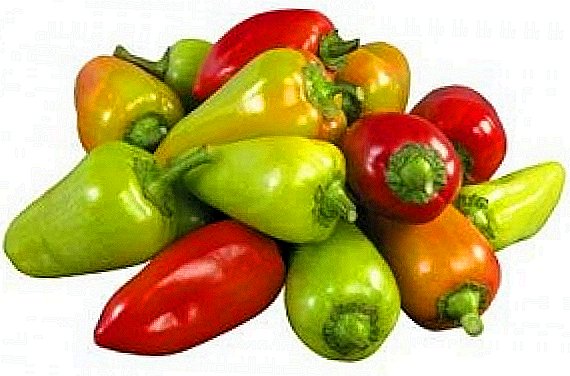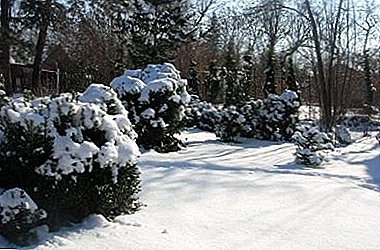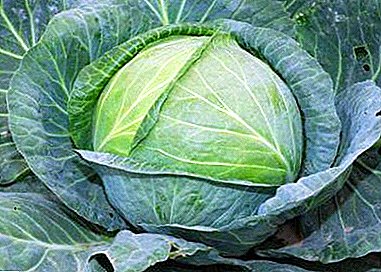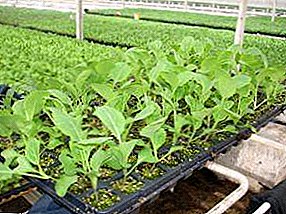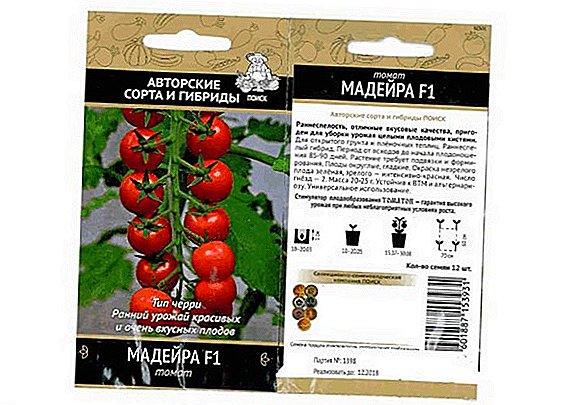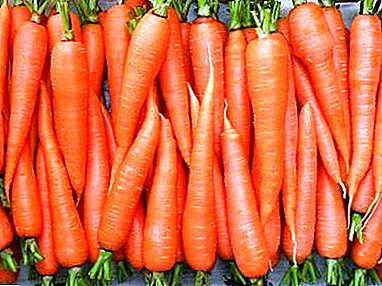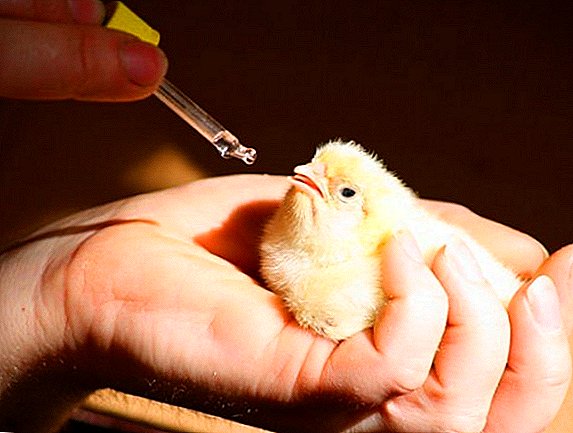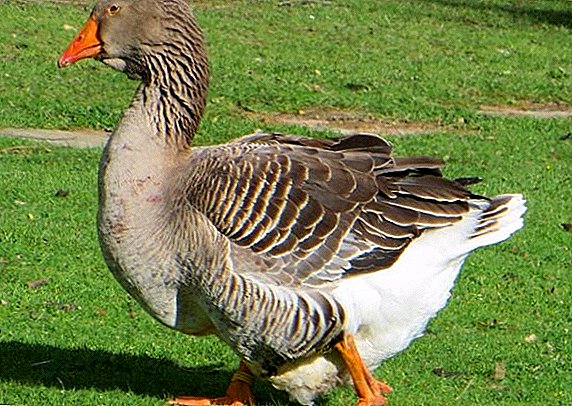 Among all the breeds of geese Toulouse enjoys the greatest distribution and fame throughout the world. She fell in love with many poultry farmers for the high taste of meat and liver, cost-effective maintenance and ease of care. In addition, the bird has a record body weight and acts as a source of a delicious delicacy - the most valuable liver. What are the peculiarities of keeping and growing geese from Toulouse, let's see.
Among all the breeds of geese Toulouse enjoys the greatest distribution and fame throughout the world. She fell in love with many poultry farmers for the high taste of meat and liver, cost-effective maintenance and ease of care. In addition, the bird has a record body weight and acts as a source of a delicious delicacy - the most valuable liver. What are the peculiarities of keeping and growing geese from Toulouse, let's see.
Origin
 It is logical to assume that the birthplace of the Toulouse geese origin is the French town of the same name, in which, through the efforts of breeders, a new breed of bird was obtained, which has high productivity and excellent profitability.
It is logical to assume that the birthplace of the Toulouse geese origin is the French town of the same name, in which, through the efforts of breeders, a new breed of bird was obtained, which has high productivity and excellent profitability.
The selection process lasted more than one year, as the scientists selected the strongest and most productive individuals to breed a new species that crossed with each other.
Genetic "framework" for Toulouse representatives served gray geese. Later, not only all regions of France, but also the states of Europe, Asia, and America began to flood the birds of this breed.
Did you know? Today, the largest center for the breeding and improvement of Toulouse geese is located in the United States. It is noteworthy, but the special demand among Americans for birds is due to the celebration of Christmas. It is from Toulouse birds that Americans prepare their signature dish - the Christmas goose.
Description and characteristics
In order to appreciate all the advantages and disadvantages of growing Toulouse geese, it is necessary to get a closer look at their external features, productivity, feeding patterns, etc. 
Appearance and physique
French birds have quite bright external qualities that make them easy to recognize among other breeds. Feathered sluggish, massive and squat. They are distinguished by pale gray in young and dark gray in adult individuals.
Their standard external signs are:
- head: wide, short with a straight orange beak;
- neck: massive medium size;
- body: wide, horizontally set;
- limbs: short, massive, powerful.
Under natural conditions, the birds have a gray color, which at the tips of the wings, neck and back turns almost black. Sometimes there are toulouse geese with brown coloring. These are very rare representatives of this breed, which received the unique name "buff-toulouse".  There are four types of birds that have a number of unique qualities:
There are four types of birds that have a number of unique qualities:
- with the presence of a "wallet" at the base of the head and a large fat fold on the abdomen;
- with the "purse", but without the abdominal fat fold;
- without a "wallet", but with a fold of fat in the abdomen;
- without a "wallet" and without folds.
The first two types are called "purse", the other two - "bezkoshelkovye." The first more massive and sedentary, but are characterized by poor fertility.
Familiarize yourself with the breeds of geese for home breeding: Rhine, Danish legart, Kholmogory, Tula.
Weight indicators
When breeding this breed, only massive birds were selected, which quickly developed and discovered their potential. Today, Toulouse geese are among the largest. The weight of an adult male can reach 12 kg. Under home conditions, on average, husks gain weight 9-11 kg.  The geese are slightly lighter and can weigh from 7 to 9 kg. Of particular value are birds as a source of delicious liver. With proper feeding and proper care, the liver in an adult feathered can reach 500 g.
The geese are slightly lighter and can weigh from 7 to 9 kg. Of particular value are birds as a source of delicious liver. With proper feeding and proper care, the liver in an adult feathered can reach 500 g.
Egg production
The egg production of geese is average, depending on the age of the female. In the first year of life, it is able to carry up to 18 eggs, in the second year - about 25 pieces, in the third - from 38 to 40 pieces. Eggs are distinguished by large size, durable white shell, weighing 180-200 g.
Learn more about the egg production of geese and the beneficial properties of goose eggs.
But as for the maternal instinct, it is poorly developed in the bird, so eggs for breeding are placed under the females of other breeds. When breeding in an incubator, approximately 50% of the eggs are fertilized. The survival rate of offspring is low, only 60%.  Juveniles grow rapidly, develop well and weigh about 4 kilograms already at the age of two months.
Juveniles grow rapidly, develop well and weigh about 4 kilograms already at the age of two months.
Did you know? American scientists have shown that the percentage of eggs fertilized in Toulouse geese increases by several times if the birds mate on the water.
Necessary conditions for the content
French geese are thermophilic, do not tolerate cold and low temperatures, so their content should adhere to the main principle: ensure heat and dryness.
Requirements for the room
A mandatory requirement for the room where geese will live is considered the presence of heat and lack of drafts. The optimum temperature in the house is +20 ° C. It should strictly control the level of humidity, it should not exceed 60-70%. In order to strengthen the immune system of birds, they clean the premises once a day.  The floor in the house should be constantly dry, with clean bedding. It is recommended to use as a material for flooring. dry straw, sawdust, peat. The latter perfectly absorbs excess moisture, thus keeping the floor dry for a long time.
The floor in the house should be constantly dry, with clean bedding. It is recommended to use as a material for flooring. dry straw, sawdust, peat. The latter perfectly absorbs excess moisture, thus keeping the floor dry for a long time.
Important! In winter, the litter layer should be at least 30 cm. In order to prevent the reproduction of pests and pathogenic microbes, slaked lime is added to the litter at the rate of 500 g per 1 square meter. m
To remove pests that can inhabit the feathers of geese, several containers filled with sand mixed with wood ash. Once in 14 days they spend bathing birds. To do this, set the trough with the decoction of medicinal herbs: chamomile, series, calendula, etc.  The premises of the house should meet the standards for calculating the livestock content. At least one livestock should be allocated at least 1.5 square meters. m square. The best option is to divide the goose in sections of 30-50 individuals. Each section should be equipped with sockets at the rate of one nest for 2-3 geese.
The premises of the house should meet the standards for calculating the livestock content. At least one livestock should be allocated at least 1.5 square meters. m square. The best option is to divide the goose in sections of 30-50 individuals. Each section should be equipped with sockets at the rate of one nest for 2-3 geese.
Did you know? Geese find a mate at the age of three years, and continue to love each other throughout their lives. If one of the pair dies, then the other is very long and it is only a few years later that he finds himself a new pair. There are those who remain lonely until the end of life. Even with home keeping, the goose, having a choice of 3-4 geese, chooses a “favorite”, which becomes the main one for all other females.
Walking and water treatments
For the normal development and growth of geese, they should be walked without fail and allowed to sunbathe. Ideally, the paddock will be located near water bodies, since birds are recommended to organize water procedures at least three times a week.  The paddock must be fenced off with any available materials: netting, reeds, rods of trees, etc. The height of an improvised fence should be 2.5 m. A lean-to canopy can be placed on the playground, where birds will hide during rain or scorching sun.
The paddock must be fenced off with any available materials: netting, reeds, rods of trees, etc. The height of an improvised fence should be 2.5 m. A lean-to canopy can be placed on the playground, where birds will hide during rain or scorching sun.
Learn how to determine the sex of geese.
What should take care in the winter
The maintenance of Toulouse in the winter period includes several important aspects:
- good nutrition enriched with minerals and vitamins;
- quality, always dry bedding, at least 30 cm thick;
- strict observance of sanitary standards: regular cleaning in the house (1 time per day), cleaning of litter;
- observance of optimum temperature condition in a goose.
 In winter, birds also need to organize walking, at least 1-1.5 hours a day. However, before releasing them to the site, it is necessary to completely remove the snow.
In winter, birds also need to organize walking, at least 1-1.5 hours a day. However, before releasing them to the site, it is necessary to completely remove the snow.
Important! Toulouse geese are quite demanding in terms of winter conditions, they can not be long on the wet and cold floor. Often sick, if you neglect the sanitary norms and do not carry out regular cleaning of the room.
What to feed
Of course, their main indicators will depend on what kind of food geese receive: productivity, general health, meat taste, etc.
Adult flock
Adult Toulouse Birds fed twice a day: in the morning and in the evening. Moreover, it is noted that most of the food geese eat at night. In the bright hours they prefer to eat in the pasture.  The basis of the menu for Toulouse should be grain and specialized combined feed. Corn, wheat, sunflower cake are best for feeding birds. Geese will not refuse from wet mash on the basis of mixed feed, boiled vegetables enriched with meat and bone meal or vitamin grass meal.
The basis of the menu for Toulouse should be grain and specialized combined feed. Corn, wheat, sunflower cake are best for feeding birds. Geese will not refuse from wet mash on the basis of mixed feed, boiled vegetables enriched with meat and bone meal or vitamin grass meal.
For a bird of this breed, the quality of the feed is more important, not its volume. Therefore, when organizing the menu, it is imperative to include mineral and vitamin supplements, which contribute to increased immunity and positively affect the growth of geese and the taste of their meat. It is also necessary to have clean, fresh water in the drinkers.
Read also about making drinking bowls for geese with your own hands.
Goslings
Goslings get their first feed immediately after hatching. The first week they are fed up to 8 times a day, using food specially designed for chicks. With each subsequent week, the number of feedings reduced to 3-4 times.  Up to thirty days of age, goslings can be fed with moist, chopped masses of cereals, wheat bran, cooked vegetables with the addition of finely chopped greens. It is good to add boiled chicken eggs to such mash. After forty days of age, the chicks can be gradually introduced into the ration of whole or coarse grains: corn, millet, barley, wheat.
Up to thirty days of age, goslings can be fed with moist, chopped masses of cereals, wheat bran, cooked vegetables with the addition of finely chopped greens. It is good to add boiled chicken eggs to such mash. After forty days of age, the chicks can be gradually introduced into the ration of whole or coarse grains: corn, millet, barley, wheat.
Important! In the diet of geese on a daily basis must be present greens.
As feeds of animal origin, goslings can be given various insects, May beetles, earthworms, and mollusks.
Advantages and disadvantages
Despite the fact that Toulouse geese require special, "gentle" conditions of housing, many farmers prefer to grow them because of the numerous meritswhich include:
- massiveness, heavy weight;
- rapid growth;
- excellent quality fluff;
- essential fat reserves;
- the possibility of obtaining a fat, large liver.
 Not devoid of breed and deficiencies, among which there are:
Not devoid of breed and deficiencies, among which there are:
- loose constitution;
- inactivity;
- poor resistance to low temperatures and high humidity;
- dietary requirements;
- low egg fertilization rate;
- poor survival of the young.
Learn how to slaughter and cut goose, as well as useful and how goose meat and fat are used.
Video: Toulouse Geese
Poultry farmers reviews about the Toulouse goose breed


Noble and whimsical, like all French, Toulouse geese require special tenderness and care when keeping. They do not tolerate high humidity, low temperatures, and often suffer from poor sanitation in the house. But at the same time, with proper care and full feeding, they are able to please their hosts with excellent meat quality and extremely tasty, delicious liver.


